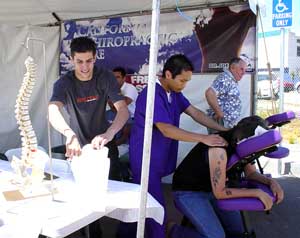-
- Gays, lesbians marry in Massachusetts
- Christian Coalition wading into judicial races
- Democrats hope for more gay and lesbian delegates at convention
- Lesbian egg donor has no parental rights to kids born from lover
- La. Senate fails to pass amendment against same-sex marriage
- Bush makes permanent his choice for AIDS office chief
- National News Briefs
- World News Briefs
san diego
GLBT Community Health Fair draws 250
Event showcases wide range of GLBT-friendly healthcare providers
Published Thursday, 20-May-2004 in issue 856
The Center and Priority Pharmacy’s third annual GLBT Community Health Fair, which took place Saturday, May 15, brought out approximately 250 people to meet healthcare providers and learn about their options regarding nutrition, mental health, domestic violence, HIV/AIDS service and prevention, insurance, holistic health and numerous health-related businesses and outreach organizations. Over 50 booths participated in the daylong event, held in The Center’s parking lot.
Priority Pharmacy’s Diana Schmid said that the fair provides a broad base for the GLBT community to explore healthcare issues, from what has traditionally focused on HIV/AIDS prevention, treatment and education.
“The fair is more of an umbrella for the LGBT community, addressing everything from family healthcare to choosing a gym,” Schmid said. “Even as a provider, the fair is an opportunity to network and to work together.”
According to Stepher Potter, Priority Pharmacy’s market development manager, the pharmacy approached The Center three years ago about coordinating the event, and the two agencies have expanded it every year since.
“This is about total equality, and total equality means access to healthcare,” Potter said. “We have to have healthcare.”
Medical providers at this year’s fair included UCSD HIV Research Centers, Coordinated Assistance Services Advocacy (CASA), Sharp Rees-Stealy Medical Centers and the Center for Surrogate Parenting & Egg Donation, Inc. San Diego Hospice and various pediatric, orthopedic, optometry and psychotherapy specialists were also on hand, as were health-oriented businesses such as Bally’s Total Fitness, several yoga studios, personal trainers, chiropractors, acupuncturists, holistic health specialists and insurance agencies.
A comprehensive GLBT 2004 Health Resource Guide was provided free of charge, with contact information for GLBT-friendly providers in the area, as well as resource links for transgender healthcare, oriental medicine, fertility and HIV/AIDS clinics and support groups.
“I advocate letting healthcare providers know about your sexual orientation,” said Shawn Ingram, director of development at The Center. Providers can better address the specific needs of a patient if they can factor in issues of sexuality and sexual identity,” he said.
Eldercare attended the event, providing information and outreach to senior GLBTs who often find their physical health and emotional well being challenged as they age. “Healthcare options get complicated as queer seniors age,” Ingram said. “Some of them have no family, and many will go back into the closet when they move into assisted living situations or with doctors. These scenarios can affect their mental health as well as access to healthcare.”
The San Diego County chapter of the National Mental Health Association provided pamphlets on depression, eating disorders, anxiety and how to deal with issues of gender, sexual orientation and prejudice.
“We’re just happy to be here,” said Margaret Beers, SDMHA program director. “People need to know that we’re there as a resource if they don’t have insurance. If people don’t know they have a place to call, they’ll let their mental health deteriorate. … The biggest challenge is to connect with the community and let people know about resources in San Diego – in all communities, we need to network.”
Beers wrote two of the articles included in the GLBT 2004 Health Resource Guide, including one entitled, “What Does Gay Mean?”, which explores bullying and harassment of GLBT and questioning youth in schools. According to the article, 78 percent of teens reported that youth who are GLBT or perceived to be are teased or bullied in schools and communities. Ninety-three percent of those surveyed said they heard other kids make derogatory comments involving sexual orientation.
Studies have shown a higher incidence of depression, anxiety disorders, drug and alcohol abuse, school failure and suicide in GLBT or questioning teens. In response, NMHA has launched a nationwide program called “What Does Gay Mean?” to help parents communicate with their children about sexual orientation prejudice.
“LGBT youth have a higher incidence of what we call ATOD – alcohol, tobacco and other drugs,” Ingram said. “Sometimes substances are used when kids feel nervous to help them feel comfortable and included, or serve as an anxiety and coping mechanism in dealing with their sexual orientation. The prevention message for youth is very important.”
Ingram said that low self-esteem can lead to abuse of alcohol, tobacco, other drugs and food, and can also promote inappropriate behavior, unsafe sex and feelings of worthlessness. The insidious effects of being closeted at any age can hinder a healthy sense of freedom, liberty and pursuit of personal identity, he added.
Michael Lamb, public relations coordinator for the GLBT Community Health Fair, said the limited number of health surveys so far conducted in the GLBT community around the nation has caused the data to be slanted. “A big issue is who you ask,” he said. “It’s like going into a mainstream bar – you’ll see more smoking and drinking than if you went to, say, a church group. Even going to a different section of Pride, you’ll see families or you’ll see parties. Who you ask, what you read and where your resources are taken from are extremely important factors to consider.”
Over time, more studies should even out these statistics, he said.
|
|
Copyright © 2003-2025 Uptown Publications


